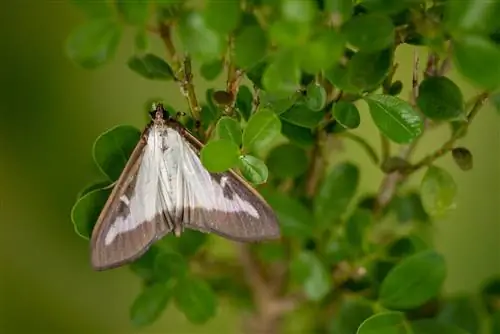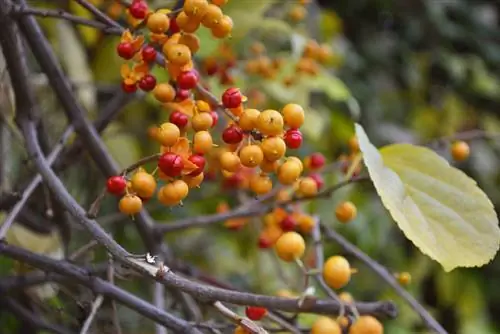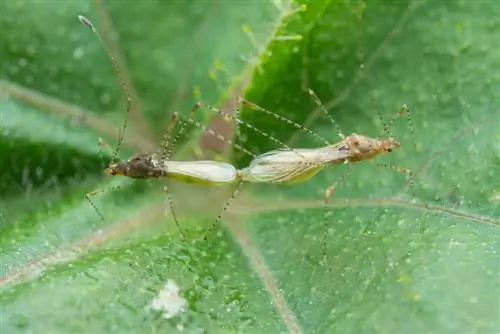- Author admin [email protected].
- Public 2024-01-05 20:48.
- Last modified 2025-06-01 06:02.
For around 12 years, hobby gardeners, especially in Germany, have been suffering from a real invasion of the box tree moth. The voracious butterfly destroys lovingly maintained Buxus hedges and ball trees in no time. Detailed knowledge about it is therefore a must for hobby gardeners.
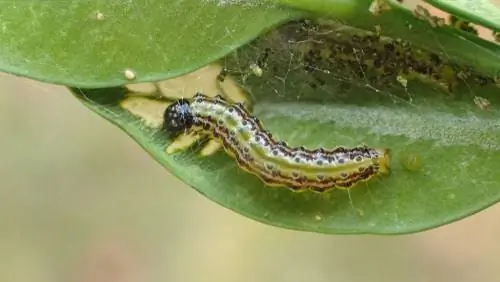
The problem of boxwood borer infestation
A boxwood borer infestation is not only annoying, but quite critical. Apart from the fact that carefully maintained box hedges or boxwood trees are unsightly eaten and covered with webs, it is also not easy to fight the boxwood moth. On the one hand, an infestation is usually only recognized when the crown is already unsightly eaten away, and on the other hand, several generations can develop within one season.
Another problem is that when you buy new plants you can get the annoying pest again. The boxwood moth has only become so widespread through the plant trade.
Is the boxwood borer poisonous?
When it comes to exotic plants and insects, you quickly wonder whether they could possibly be poisonous to people, birds or other animals. This is only indirectly the case with the boxwood moth. It itself is not initially poisonous - but it becomes so as the boxwood grows. The plant contains some poisons, especially alkaloids, which the larvae store in their bodies when they eat. As a result, the predators mentioned above also ingest these poisons when they feast on the caterpillars. However, this does not seem to pose a serious danger to the songbirds.

The boxwood borer itself is not poisonous
What to do about the boxwood borer?
If an infestation is already underway, it is important to take countermeasures as early as possible. If you're thorough with the first generation, you might have peace of mind for the rest of the season.
Basically, for the sake of nature and your own he alth, you should always try to combat the box tree borer organically first.
Mechanical methods
Especially if the infestation is not yet very advanced, it is advisable to first deal with the pest mechanically. This is the best way to fulfill the credo of “fighting naturally”.
Mechanical methods are:
- Collect
- Cumshot
- Blow off
If the number of larvae is manageable, you can collect the animals with tweezers, for example, which of course requires some skill.
The slightly rougher version is the garden hose or low-pressure cleaner or a leaf blower. You can use this to rinse or blow the caterpillars out of the bush and catch them on a sheet of foil previously spread under the plant.

Ecological means: Boxwood borer control without chemicals
Effective chemical-free agents are:
- Bacillus thuringiensis products
- Oil products
- Vinegar
- Lime and rock powder
Bacillus thuringiensis - Xentari
The bacterium Bacillus thuringiensis is an effective means of biological control of the box tree borer - it parasitically colonizes the caterpillars and thereby causes them to die. Products containing the bacillus are sold under the name Xentari, for example from the Neudorff company “Caterpillar Free”.
Neem
Neem oil-based products are currently booming as gentle crop protection products. They are also an effective help against boxwood borer pests. The active ingredient azadriachtin from the neem tree seeds is stored in the leaves of the boxwood and inhibits the moulting and thus the development of the caterpillars. What is particularly advantageous is that they stop eating the leaves immediately. Please note that if possible, neem oil treatment should not be carried out over high heat. In hot weather phases, it is best to spray after sunset.
In order to distribute the active ingredient as thoroughly as possible on the Buxus, we recommend using a concentrate. This is diluted with water (the ratio is stated on the product container) and placed in a disperser. To reduce the surface tension of the mixture, you can add a drop of detergent or a little soft soap to it. This allows you to achieve more thorough area coverage and better success rates.
Ballistol Oil
Ballistol oil can also be used as an antidote for a boxwood borer infestation. The advantage is that the product is available ready-made in spray cans. This makes it easier to use. The oil works primarily by hindering the gas exchange of the eggs and blocking the respiratory tract of the larvae.
Vinegar
Vinegar is also one of the tried and tested home remedies against the box tree borer. It makes the leaves of the book inedible for pests. It is best if you combine the vinegar with other home remedies, i.e. with oil and a little water. This adds to the airway-clogging effect and increases the overall effect.
Baking powder
Baking powder has always had many uses other than in cake batter. In addition to stains, it is also said to help against the boxwood moth. To do this, a solution is mixed with water and sprayed onto the box using a disperser.
Lime
Algae lime in powder form is usually used successfully against fungal diseases on boxwoods. But lime can also work against the box tree borer. The leaves coated with lime powder are unattractive for the larvae to eat. You can also try it with finely crushed shell limestone.
Primitive rock flour
A similar effect can be achieved with primary rock powder. If the rock dust is deposited on the leaves of the boxwood, it becomes more difficult for the borer to lay eggs.
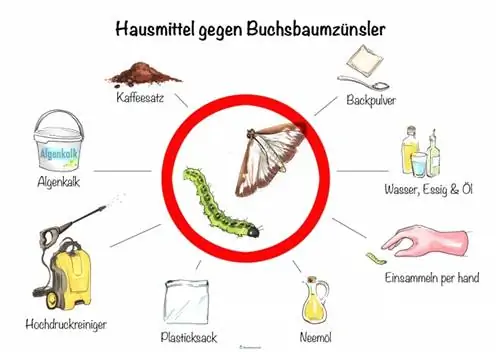
When to inject?
You should apply a spray treatment with ecological control liquids as soon as you notice a population of boxwood borers. It is always better if you completely eradicate the first generation of borers during the season and thus prevent a subsequent generation. To effectively eliminate a pest population, you should give three thorough sprays over a period of approximately 3 weeks.
Chemical agents
Chemical agents are of course generally not recommended because of their generally damaging effects on the biosystem of the garden and the environment. However, if none of the ecological remedies help and you see no other way out, you can also resort to them.
Calypso
The product “Pest Free Calypso” from Bayer is effective. Aside from its not exactly environmentally friendly nature, its use can also harm you. In particular, allergic reactions can occur upon skin contact; under no circumstances should the product get into the eyes or be swallowed.
Lizetan
Under the trade name “Lizetan”, the company Protect Garden sells a spray that is based on the synthetically produced neem oil tree active ingredient azadriachtin. For example, the product “Lizetan Pest Free” has proven to be very effective for the box tree borer. In principle, it has the same systemic effect as organic neem products, but is less gentle and can cause allergic reactions.
Bi 58
Bi 58 is not approved for outdoor use, only use on ornamental plants in greenhouses is permitted. Bi 58 is a ready-to-use spray that works with the active ingredients abamectin and pyrethrins. Abamectin has a damaging effect on the nervous system of pests, while pyrethrins act as a contact poison. The sprayed insects die quickly, but the agent has a long-term damaging, toxic effect on aquatic organisms.
Careo
The insecticide “Pest Free Careo” from Celaflor is also a chemical spray that can be used against the box tree borer. Its active ingredient is the feeding poison acetamiprid, which leads to paralysis and the death of the pests. However, the concentrate is also toxic to aquatic organisms.
Pheromone Traps
Traps can also be used to combat boxwood borer populations. Pheromone traps in particular are used against the pest. A pheromone trap takes advantage of the scent attraction during the mating process of pest insects. Synthetically produced attractants of female insects, technically known as pheromones, are either combined with glue on tablets or injected into a trap container. With the first method, the attracted male insects simply stick, while with the second method they end up in the trap container from which they can no longer leave. By catching the male boxwood butterflies, the mating quota and thus reproduction is reduced.
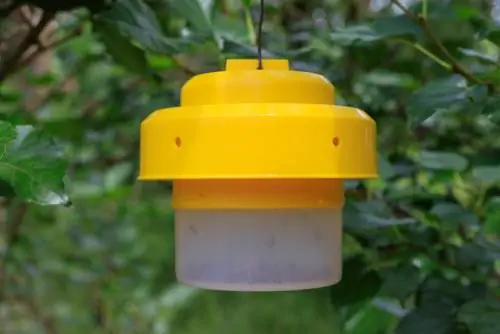
Pheromone traps have a rather weak effect
How it works
The container traps usually consist of a trap body and two depot chambers for the attractant, a pheromone gel, which is filled in using a syringe. This gel is usually also available as a refill pack. Traps from Natria (Bayer), Solabiol or Neudorff, for example, work with this principle. The Neudorff trap is available under the brand name Neudomon as a specific boxwood moth variant.
Experiences: moderate effectiveness
The trap method is quite inexpensive because all you have to do is hang the trap and refill the attractant depots once every few weeks throughout the season. However, the effect is nowhere near as effective as targeted treatments on boxwood using home remedies and spray treatments. The number of males is ultimately only reduced slightly, but by no means set to zero. As a rule, there are still individuals left who can mate with females.
Pheromone traps are therefore actually used more in agriculture and forestry for monitoring, i.e. to diagnose a population size, and less for actual damage limitation. In this respect, you can also use such traps for inspection, i.e. to determine whether boxwood moths are actually in your garden. This is how you can prepare for targeted combat.
Tip
So that you don't get into trouble with the box tree borer in the first place, it's worth taking precautions. This starts with getting the plants. Before buying, inspect a boxwood with an eagle's eye: If you see fine webs or small droppings, a boxwood moth infestation is almost certain.
Covering boxwood trees with a fine net can also be helpful as it stops the butterflies from laying their eggs.
Dispose of infected boxwood trees
Finally, a word should be said about the correct disposal of infected boxwood branches or entire plants. Since the pest has spread so massively in recent years, every hobby gardener has a certain responsibility to prevent further spread. Although there is no official obligation to report a box tree borer infestation, in the interest of the general gardening community, the fight should be carried out as thoroughly as possible.
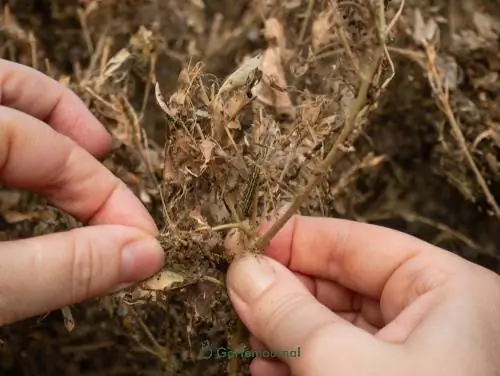
Infected plant parts should under no circumstances be composted
It's important:
- No disposal on the compost heap
- Ideal: Burn
Infested plant material does not belong in the compost
So if you are struggling with a strong, stubborn population and your boxwoods are badly eaten, it is necessary to thoroughly remove infested plant material, not only for aesthetic reasons but also to prevent further spread. Pupated borers can still be found on the eaten and dead shoots of a Buxus that come together after a radical cut. So that they cannot cause any further damage, the clippings must under no circumstances be disposed of in the compost. There the caterpillars can develop further and the trouble begins again.
Burning is best
It is best to have cut, infected boxwood branches burned in a recycling plant. This is the safest way to kill the pest. At the very least, you should dispose of the clippings in household waste, where any remaining larvae have a lower chance of developing into moths.
Particularly vulnerable areas
In Germany, the Rhineland, the Rhine-Main area and the southwest are particularly badly affected by the box tree moth plague. The pest feels particularly comfortable here because of the warm climate. That's why the German Horticultural Association explicitly warns against planting box trees in these regions.
Background
Facts about the boxwood moth
Zoology, origin and distributionThe zoological name of the boxwood moth is Glyphodes perspectalis and is a small butterfly. It belongs to the family of weevils, which are mainly found in tropical regions. The boxwood moth is also not native to us. It originally comes from East Asia, from where it was introduced to Central Europe around 2007 - probably through the plant trade. Since then, its spread has become widespread, to the chagrin of many hobby gardeners. Unfortunately, he's not easy to fight either. But you still don't have to give up.
In order to recognize the boxwood moth, you also need an attentive eye because the caterpillars are difficult to spot in the green boxwood leaves. However, the earlier an infestation is detected, the higher the chances of successful control.
Appearance of the mothsAn adult boxwood moth has a wide, splayed triangular shape about 40 mm wide and 25 mm long. Its wings are creamy white and edged with brown. In the middle of the upper brown edge, if you look closely, you can see a small, crescent-shaped spot on both sides. But there are also completely brown specimens.
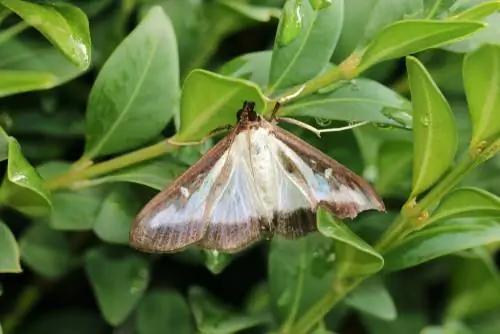
The boxwood moth's butterflies are rather inconspicuous
Appearance of the caterpillarsThe boxwood borer caterpillar is about 5 cm long and yellowish-green in color. A black-brown-white dotted stripe pattern runs along the back. The head is black and the caterpillar has white bristles all over its body.
Actual damage caused by larvae
The real culprits that cause the destroyed box trees are not the adult butterflies, but the larvae. Once a boxwood moth has grown into a full-fledged butterfly, its sole task is to care for offspring and doesn't live long after that. The pest spends the main part of its existence preparing itself for its egg-laying purpose by eating. As a butterfly, it spends less time on box trees and more on other plants.
The boxwood moth, on the other hand, always lays its eggs on boxwoods. The larvae hatch there and cover themselves in white webs over the winter. Only when the frost noticeably disappears do the caterpillars become active. Then they leave their web cave and begin to feast on the leaves of their host plant. This gives them energy to grow and complete several stages of development. Finally, like all butterflies, they retreat into a chrysalis in order to transform into a moth.
malicious image
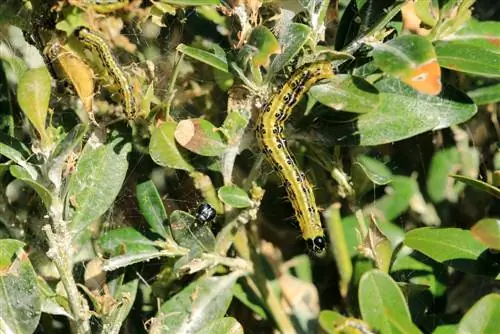
Webs and eaten leaves are a sure sign of a boxwood moth infestation
Since the hatched boxwood moth caterpillars overwinter in relatively easily visible webs in the boxwood, you can already detect an infestation in the cold season.
When the caterpillars start their voracious activity in March, the plant is gradually stripped of its leaves and, without countermeasures, soon presents a sadly naked picture. So keep an attentive eye on your box from March at the latest - because the caterpillars start to eat from the inside of the crown, so that the tree looks perfect on the outside for even longer.
If there are no juicy leaves left, the caterpillars also attack the bark of the younger shoots and cause them to die. By the way, a clear indication of a boxwood borer plague is the leaf skeletons that remain standing, as these are spurned by the parasites.
Predators
The boxwood borer only recently immigrated to us and its natural predators from China and Co. did not accompany it. Nevertheless, some adaptable native animal species seem to have adapted to the new food supply and added boxwood moth larvae to their diet. These primarily include sparrows, chaffinches, great tits and some species of wasps.
Can a boxwood be resistant to the boxwood borer?
As the boxwood borer massively spreads, the demand for Buxus varieties that are resistant to the pest is naturally increasing. After all, the boxwood is part of the firmly established cultural heritage of local gardening history and has a great following.
Sobering Reality
Unfortunately, there are currently no resistant Buxus varieties. So if you absolutely don't want to do without the classic hedge and ball-cut plant, you have to live with the risk of borer infestation and, if the worst comes to the worst, accept the cost of fighting it.
Little ray of hope
But it is somewhat consoling that there are at least variants that seem to be a little less susceptible. These primarily include the varieties of small-leaved boxwood, botanically Buxus microphylla. Attractive varieties include the 'Herrenhausen' or the 'Faulkner'.
If you want to be on the safe side and are not too attached to the real Buxus, switching to similar small trees is also worth considering. In this way you can avoid the annoying borer in the long term and still enjoy cutting-friendly, precisely shapeable and robust shrubs.
Suggestions would be:
- Dwarf Privet
- Dwarf Yew
- Small-leaved Rhododendron
Dwarf Privet
Dwarf privet varieties in particular are an alternative to boxwood. With its small, elliptical leaves it is very similar to the boxwood and also has a very comparable, low-density habit. Compared to other privet species, it remains quite small at 70 to 100 cm high and also grows quite slowly. It is also undemanding, hardy and evergreen.
Dwarf Yew
The dwarf yew tree, for example, has a slightly needleier, but just as dark green and dense appearance. Like boxwood, it can be cultivated in a pot to create clearly shaped silhouettes and is also evergreen. The small tree is also suitable as a bed border. A nice addition is the red berry fruit decoration!
Small-leaved Rhododendron
The small-leaved rhododendron has slightly larger, but small leaves for its genus. Like the dwarf yew, it grows compact and spherical and is therefore suitable as a boxwood replacement. It is also very robust and evergreen and boasts decorative flowers.



